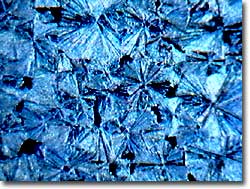Chemical Crystal Movie Gallery
Piperidone Time Lapse Sequence
The piperidones are a family of organic chemicals characterized by a 6-carbon ring having a substituted nitrogen and a double-bonded oxygen atom. Utilized by pharmaceutical companies and chemical manufacturers as intermediates in production of other compounds, piperidones are named by the location of the nitrogen or amine group on the ring, and the position of any other side chains.

Commercially available N-methyl piperidone derivatives include N-acetyl piperidone, N-benzyl piperidone, N-t-butyl piperidone, N-carbethoxy piperidone, 4-chloro-N-methyl piperidine, and 4-hydroxy-N-methyl piperidine. These organic compounds are used in the removal of sulfur compounds from gases, to synthesize organic photoreceptors, to manufacture pharmaceuticals, and to create other commercially important chemicals. Several of the piperidone ring compounds are playing a role in Alzheimer's research for their possible prevention of fibrillogenesis and for enhancing the solubility of alpha-beta-blockers.
Marketed by DuPont as Xolvone, dimethyl-2-piperidone (DMPD) is a blend of two isomers that is cleared by the U.S. Environmental Protection Agency for the cleaning of semiconductor wafers and photoresist stripping in electronic fabrication processes. It is more environmentally benign than the carcinogenic and toxic organic solvents historically used by the electronics industry. In fact, the U.S. Department of Transportation does not regulate the shipment of this piperidone compound as a hazardous material, saving manufacturers and users money and time. Other applications for DMPD include industrial degreasing and metal cleaning, resin cleanup, ink formulations, and industrial hydrocarbon extractions.
As a colorless and mildly odoriferous liquid, dimethyl-2-piperidone exhibits a boiling point ranging from 221 to 233 degrees Celsius, varying with the particular isomer, and a freezing point of -50 degrees Celsius. The flash point of DMPD is 94 degrees Celsius (or 202 degrees Fahrenheit), and the compound is characterized by a viscosity of 3.4, a surface tension of 35.9 dynes per centimeter, and a density of 0.992 grams per milliliter, at 25 degrees Celsius. At temperatures greater than 350 degrees Celsius, this organic compound decomposes into hazardous carbon monoxide, nitrogen oxides, and ammonia gases. Known also as dimethyl gamma valerolactam, dimethyl-2-piperidone is not considered a carcinogen, although if contacted, it may cause eye and skin irritations.
Piperidone Time Lapse Sequence #1 - A time-lapse sequence of 19 images illustrates the crystallization of rosette-like structures from a number of nucleation sites, merging into a field of uniform birefringence.
Contributing Authors
Omar Alvarado, Thomas J. Fellers and Michael W. Davidson - National High Magnetic Field Laboratory, 1800 East Paul Dirac Dr., The Florida State University, Tallahassee, Florida, 32310.
BACK TO THE CHEMICAL CRYSTAL MOVIE GALLERY
BACK TO THE DIGITAL IMAGE GALLERIES
Questions or comments? Send us an email.
© 1995-2025 by Michael W. Davidson and The Florida State University. All Rights Reserved. No images, graphics, software, scripts, or applets may be reproduced or used in any manner without permission from the copyright holders. Use of this website means you agree to all of the Legal Terms and Conditions set forth by the owners.
This website is maintained by our
Graphics & Web Programming Team
in collaboration with Optical Microscopy at the
National High Magnetic Field Laboratory.
Last Modification Friday, Nov 13, 2015 at 01:19 PM
Access Count Since September 17, 2002: 16594
Visit the website of our partner in introductory microscopy education:
|
|
